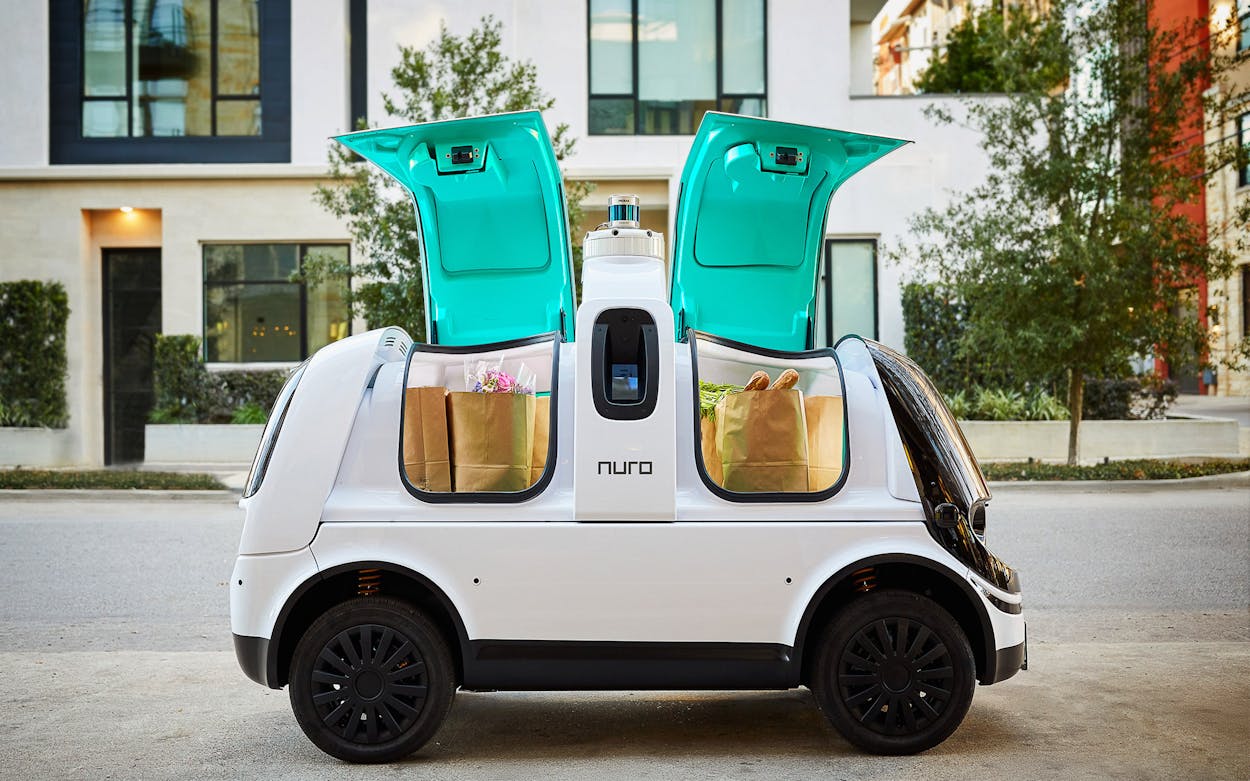The pandemic has dealt a crushing blow to the world of commerce, reducing a bustling economy to levels of collapse not seen since the Depression. The aftershocks have rippled across the food industry, in particular, disrupting industrial production and shuttering restaurants, bars, and businesses that feed off them. But amid the economic carnage, a number of businesses ended up benefiting from sudden, drastic changes in public behavior. Some of these outliers—such as Purell, the hand sanitizer company, or Zoom, the conferencing platform—were established brands even before the pandemic. Others, like Nuro, a Silicon Valley robotics company that has deployed a fleet of driverless delivery vehicles in Houston, were relatively unknown start-ups that found themselves suddenly in high demand.
As recently as last fall, Nuro appeared to be years away from widespread adoption. The company, which operated in Arizona and California, arrived in Houston in 2018 to test its vehicles on a city known for its diversity, with a wide range of neighborhoods and types of customers. Though the cars were overseen by two human employees in the front seat, the goal was to develop the world’s preeminent fully autonomous delivery service. The robotically piloted Toyota Priuses, equipped with remote sensing equipment on top, became a fairly common sight in central Houston neighborhoods. But before the pandemic, most people didn’t pay them much attention.
Last fall, only 3 percent of the nation’s households were placing frequent online orders for grocery delivery. The low rate was attributed to shoppers’ concerns about higher prices online and delivery drivers showing up late. In May of this year, however, that number had skyrocketed to 33 percent, a stunning increase that—in even the best case scenarios—was expected to take many years to reach, not months. In Houston alone, Nuro has seen its deliveries triple into the thousands since the pandemic turned in-person shopping into risky activity. Suddenly, Nuro was no longer a novelty, but an important aid for many Houstonians sheltering in place.
That same trend has been replicated by other automated delivery services during the pandemic, as companies including Waymo and Starship, makers of a sidewalk delivery robot, find themselves in greater demand than ever before. “Investors over the past seven months have pumped at least $6 billion into more than two dozen companies involved in autonomous delivery of goods and food, from drones to heavy trucks,” Reuters reported in May.
In addition to partnering with Kroger, the nation’s largest operator of traditional supermarkets, Nuro delivers prescriptions from CVS and will soon deliver Domino’s pizza. The company expects much of its new customer base to remain after the pandemic, believing that quarantine has only amplified an existing trend toward on-demand grocery delivery. Sola Lawal, a Nuro product operations manager based in Houston who formerly worked for Uber, cites high customer appreciation scores as evidence that new users will remain loyal to the brand.
When I spoke to Lawal, I asked him what he would have thought if someone had shown him those heightened delivery numbers last fall.
“I’m not sure what I would’ve thought,” he said. “I just know I would’ve been very confused.”
The pandemic hasn’t just rapidly expanded the company’s customer base and delivery volume, it’s also forced them to adapt. The company still relies on Nuro employees to oversee the autonomous vehicles, collect valuable information about how they perform on the road, and unload groceries gathered by workers at Kroger. Last fall, when driverless vehicles arrived at a home with groceries in tow, a human operator sitting in the passenger seat would hand the goods over to customers or deliver them to the front door. In Houston, some families had a habit of meeting the vehicles at the curb with a red wagon. “It was like a mini family celebration,” Lawal explained.
With person-to-person interaction no longer safe, Nuro’s engineers rushed to develop a new system that would allow customers to open a delivery vehicle’s doors by flashing a thumbs-up sign or using a setting on their mobile phone. (Both the hand gesture and smartphone features are available only on vehicles in California for now.)
“Creating contact-less delivery was a long-term goal that got sped up when it became clear that, yeah, we need to be able to do this now!” Lawal said.
Since the pandemic began, the types of groceries customers are purchasing has begun to change as well, in some revealing ways. During the early days of the pandemic, adult beverage sales spiked by 63 percent, with beer increasing by 71 percent, wine by 54 percent, and spirits by 67 percent, according to consumer shopping data from Kroger. By the end of May, however, those numbers had leveled out, but hand sanitizer sales—not surprisingly—had jumped 263 percent compared with their yearly average. Over the past few months, the data reveals, yeast and other baking essentials have seen an 80 percent increase in sales.
There also has been a discernible change in customers’ attitudes, Lawal said, ever since the pandemic turned an ordinary trip to the grocery store into a high-risk activity.
“Before the pandemic customers’ attitudes were like, ‘This is cool and now I have the groceries I need,’” he said, “and now they’re more like, ‘Oh, thank God!’”








